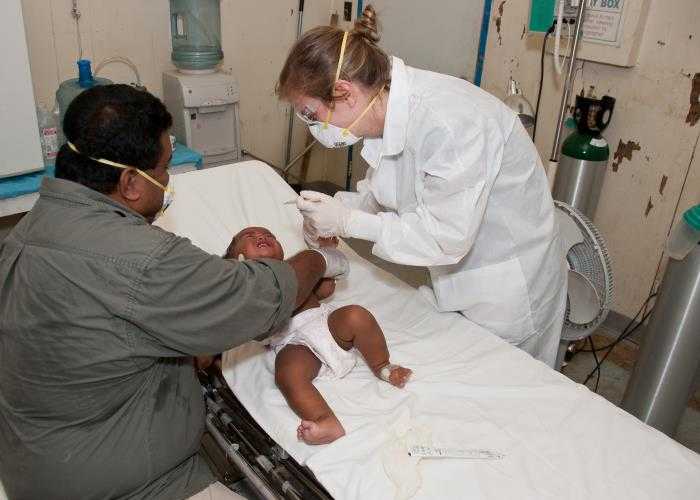Measles

CDC Epidemic Intelligence Service (EIS) Officer, Lucy Breakwell, Ph.D., M.Sc. obtaining a nasopharyngeal swab from a child with measles. By Centers for Disease Control and Prevention (CDC) Medical Epidemiologist, Umid Sharapov, M.D., M.Sc. View this image or search images by topic on the Public Health Image Library (PHIL)
Measles is an acute viral infectious disease. References to measles can be found from as early as the 7th century. The disease was described by the Persian physician Rhazes in the 10th century as “more to be dreaded than smallpox.” Despite the fact that it is preventable through vaccination, measles remains a common disease in many parts of the world, including areas in Europe, Asia, the Pacific, and Africa.
What is the global impact of measles?
- Worldwide, 36 cases of measles per 1 million persons are reported each year; about 134,200 die.
- For every 1,000 children who get measles, one or two will die from it. As many as one out of every 20 children with measles gets pneumonia, the most common cause of death from measles in young children. About one child out of every 1,000 who get measles will develop encephalitis (swelling of the brain) that can lead to convulsions and can leave the child deaf or with intellectual disability.
Who is at risk?
- Measles is highly contagious and spread through airborne transmission (person-to-person through sneezing or coughing).
- Measles can be a serious in all age groups. However, children younger than 5 years of age and adults older than 20 years of age are more likely to suffer from measles complications. Common measles complications include ear infections and diarrhea. Some people may suffer from severe complications, such as pneumonia (infection of the lungs) and encephalitis (swelling of the brain). They may need to be hospitalized and could die.
- Subacute sclerosing panencephalitis (SSPE) is a very rare, but fatal disease of the central nervous system that results from a measles virus infection acquired earlier in life. SSPE generally develops 7 to 10 years after a person has measles, even though the person seems to have fully recovered from the illness.
- Measles is a serious and potentially fatal disease, but it can be prevented through vaccination. The vaccine can be delivered as a combined measles-rubella (MR) vaccine, or combined with vaccines against mumps (MMR) and varicella (chickenpox) (MMRV).
What is CDC doing?
- As a founding member of the Measles and Rubella Initiative (M & RI), launched in 2001, CDC provides both scientific and technical support to partners and countries in other parts of the world to reduce measles and rubella deaths. CDC played a key role, in partnership with the Pan American Health Organization (PAHO), to develop a regional measles elimination strategy in 1996, and in 2016, measles and rubella were eliminated in the Western Hemisphere (Americas). We know that it can be done in the rest of the world!
- As part of the Measles and Rubella Initiative, the CDC:
- Helps plan at a macro-and micro-level, implement, monitor, and evaluate measles and rubella vaccination campaigns in targeted areas to eliminate measles, rubella and CRS.
- Conducts operational research to provide evidence for recommendations that strengthen and guide measles- and rubella-control activities at the local, regional, and global levels.
- Helps evaluate the burden of rubella and CRS in countries to provide evidence for the introduction of rubella-containing vaccines.
- Provides technical assistance to conduct measles and rubella outbreak investigations, surveillance reviews, and routine vaccination program evaluations.
- Helps create and/or strengthen case-based measles, rubella, and CRS surveillance systems that allow countries to detect, monitor, and quickly respond to the presence of measles, rubella, and CRS.
- Serves as the global reference laboratory for measles and rubella.
- Provides resources for national reference laboratories.
- Provides technical assistance to global public health laboratories for the collection and shipment of clinical samples for measles testing using real-time polymerase chain reaction (RT-PCR).
Additional Resources
- Download Measles and Rubella fact sheet
- Read CDC’s latest global measles news releases
- Browse Global Measles images on the CGH Flickr stream or search by topic or country
- Search images by topic on the Public Health Image Library (PHIL)
- Learn more about measles and vaccine preventable diseases
Contact Media Relations
Contact media relations to speak with a CDC Measles expert
-
9:00 a.m. – 6:00 p.m.
(404) 639-3286
media@cdc.gov
-
After Hours
(770) 488-7100
Media Request Form
- Page last reviewed: September 18, 2017
- Page last updated: September 18, 2017
- Content source:
Global Health
Notice: Linking to a non-federal site does not constitute an endorsement by HHS, CDC or any of its employees of the sponsors or the information and products presented on the site.


 ShareCompartir
ShareCompartir